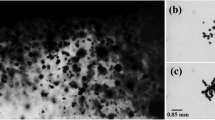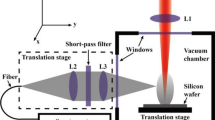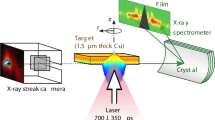Abstract
Single-bubble sonoluminescence (SBSL1,2,3,4,5) results from the extreme temperatures and pressures achieved during bubble compression; calculations have predicted6,7 the existence of a hot, optically opaque plasma core8 with consequent bremsstrahlung radiation9,10. Recent controversial reports11,12 claim the observation of neutrons from deuterium–deuterium fusion during acoustic cavitation11,12. However, there has been previously no strong experimental evidence for the existence of a plasma during single- or multi-bubble sonoluminescence. SBSL typically produces featureless emission spectra13 that reveal little about the intra-cavity physical conditions or chemical processes. Here we report observations of atomic (Ar) emission and extensive molecular (SO) and ionic (O2+) progressions in SBSL spectra from concentrated aqueous H2SO4 solutions. Both the Ar and SO emission permit spectroscopic temperature determinations, as accomplished for multi-bubble sonoluminescence with other emitters14,15,16. The emissive excited states observed from both Ar and O2+ are inconsistent with any thermal process. The Ar excited states involved are extremely high in energy (>13 eV) and cannot be thermally populated at the measured Ar emission temperatures (4,000–15,000 K); the ionization energy of O2 is more than twice its bond dissociation energy, so O2+ likewise cannot be thermally produced. We therefore conclude that these emitting species must originate from collisions with high-energy electrons, ions or particles from a hot plasma core.
This is a preview of subscription content, access via your institution
Access options
Subscribe to this journal
Receive 51 print issues and online access
$199.00 per year
only $3.90 per issue
Buy this article
- Purchase on Springer Link
- Instant access to full article PDF
Prices may be subject to local taxes which are calculated during checkout




Similar content being viewed by others
References
Barber, B. P. & Putterman, S. J. Light scattering measurements of the repetitive supersonic implosion of a sonoluminescing bubble. Phys. Rev. Lett. 69, 3839–3842 (1992)
Gompf, B., Günther, R., Nick, G., Pecha, R. & Eisenmenger, W. Resolving sonoluminescence pulse width with time-correlated single photon counting. Phys. Rev. Lett. 79, 1405–1408 (1997)
Gaitan, D. F., Crum, L. A., Church, C. C. & Roy, R. A. Sonoluminescence and bubble dynamics for a single, stable, cavitation bubble. J. Acoust. Soc. Am. 91, 3166–3183 (1992)
Lohse, D., Brenner, M. P., Dupont, T. F., Hilgenfeldt, S. & Johnston, B. Sonoluminescing air bubbles rectify argon. Phys. Rev. Lett. 78, 1359–1362 (1997)
Brenner, M. P., Hilgenfeldt, S. & Lohse, D. Single-bubble sonoluminescence. Rev. Mod. Phys. 74, 425–484 (2002)
Moss, W. C., Clarke, D. B. & Young, D. A. Calculated pulse widths and spectra of a single sonoluminescing bubble. Science 276, 1398–1401 (1997)
Moss, W. C. et al. Computed optical emissions from a sonoluminescing bubble. Phys. Rev. E 59, 2986–2992 (1999)
Burnett, P. D. S. et al. Modeling a sonoluminescing bubble as a plasma. J. Quant. Spectrosc. Radiat. Transfer 71, 215–223 (2001)
Hilgenfeldt, S., Grossmann, S. & Lohse, D. A simple explanation of light emission in sonoluminescence. Nature 398, 402–405 (1999)
Yasui, K. Mechanism of single-bubble sonoluminescence. Phys. Rev. E 60, 1754–1758 (1999)
Taleyarkhan, R. P. et al. Evidence for nuclear emissions during acoustic cavitation. Science 295, 1868–1873 (2002)
Taleyarkhan, R. P. et al. Additional evidence of nuclear emissions during cavitation. Phys. Rev. E 69, 036109 (2004)
Hiller, R., Weninger, K., Putterman, S. J. & Barber, B. P. Effect of noble gas doping in single-bubble sonoluminescence. Science 266, 248–250 (1994)
McNamara, W. B. III, Didenko, Y. T. & Suslick, K. S. Sonoluminescence temperatures during multi-bubble cavitation. Nature 401, 772–775 (1999)
Flint, E. B. & Suslick, K. S. The temperature of cavitation. Science 253, 1397–1399 (1991)
Didenko, Y. T., McNamara, W. B. III & Suslick, K. S. Effect of noble gases on sonoluminescence temperatures during multibubble cavitation. Phys. Rev. Lett. 84, 777–780 (2000)
Didenko, Y. T., McNamara, W. B. III & Suslick, K. S. Molecular emission from single-bubble sonoluminescence. Nature 407, 877–879 (2000)
Greenewalt, C. H. Partial pressures of aqueous solutions of sulfuric acid. J. Ind. Eng. Chem. 17, 522–523 (1925)
Troia, A., Ripa, D. M. & Spagnolo, R. in World Congress on Ultrasonics (ed. Cassereau, D.) 1041–1044 (Société Française d'Acoustique, Paris, 2003)
Vazquez, G., Camara, C., Putterman, S. & Weninger, K. Sonoluminescence: Nature's smallest blackbody. Opt. Lett. 26, 575–577 (2001)
Didenko, Y. T. & Suslick, K. S. The energy efficiency of formation of photons, radicals and ions during single-bubble cavitation. Nature 418, 394–397 (2002)
Wiese, W. L., Brault, J. W., Danzmann, K., Helbig, V. & Kock, M. Unified set of atomic transition probabilities for neutral argon. Phys. Rev. A. 39, 2461–2471 (1989)
Toegel, R. & Lohse, D. Phase diagrams for sonoluminescing bubbles: A comparison between experiment and theory. J. Chem. Phys. 118, 1863–1875 (2003)
Cooper, R., Grieser, F., Sauer, M. C. Jr & Sangster, D. F. Formation and decay kinetics of the 2p levels of neon, argon, krypton, and xenon produced by electron-beam pulses. J. Phys. Chem. 81, 2215–2220 (1977)
Zel'dovich, Y. B. & Raizer, Y. P. Physics of Shock Waves and High-Temperature Hydrodynamic Phenomena (Academic, New York, 1966)
Tourin, R. H. Spectroscopic Gas Temperature Measurement (Elsevier, Amsterdam, 1966)
Camara, C., Putterman, S. & Kirilov, E. Sonoluminescence from a single bubble driven at 1 megahertz. Phys. Rev. Lett. 92, 124301 (2004)
Yasui, K. Single-bubble sonoluminescence from noble gases. Phys. Rev. E 63, 035301 (2001)
Ajello, J. M. et al. Middle ultraviolet and visible spectrum of SO2 by electron impact. J. Geophys. Res. Space 107, SIA2 (2002)
Schappe, R. S., Schulman, M. B., Sharpton, F. A. & Lin, C. C. Emission of the O2 + (A2Πu → X2Πg) second-negative-band system produced by electron impact on O2 . Phys. Rev. A 38, 4537–4545 (1988)
Acknowledgements
This work was supported by the National Science Foundation and the US Defense Advanced Research Projects Agency. We acknowledge conversations with F. Grieser on the mechanism of Ar atom emission, and with L. A. Crum, D. Lohse, W. C. Moss and S. J. Putterman.
Author information
Authors and Affiliations
Corresponding author
Ethics declarations
Competing interests
The authors declare that they have no competing financial interests.
Rights and permissions
About this article
Cite this article
Flannigan, D., Suslick, K. Plasma formation and temperature measurement during single-bubble cavitation. Nature 434, 52–55 (2005). https://doi.org/10.1038/nature03361
Received:
Accepted:
Issue Date:
DOI: https://doi.org/10.1038/nature03361
Comments
By submitting a comment you agree to abide by our Terms and Community Guidelines. If you find something abusive or that does not comply with our terms or guidelines please flag it as inappropriate.



